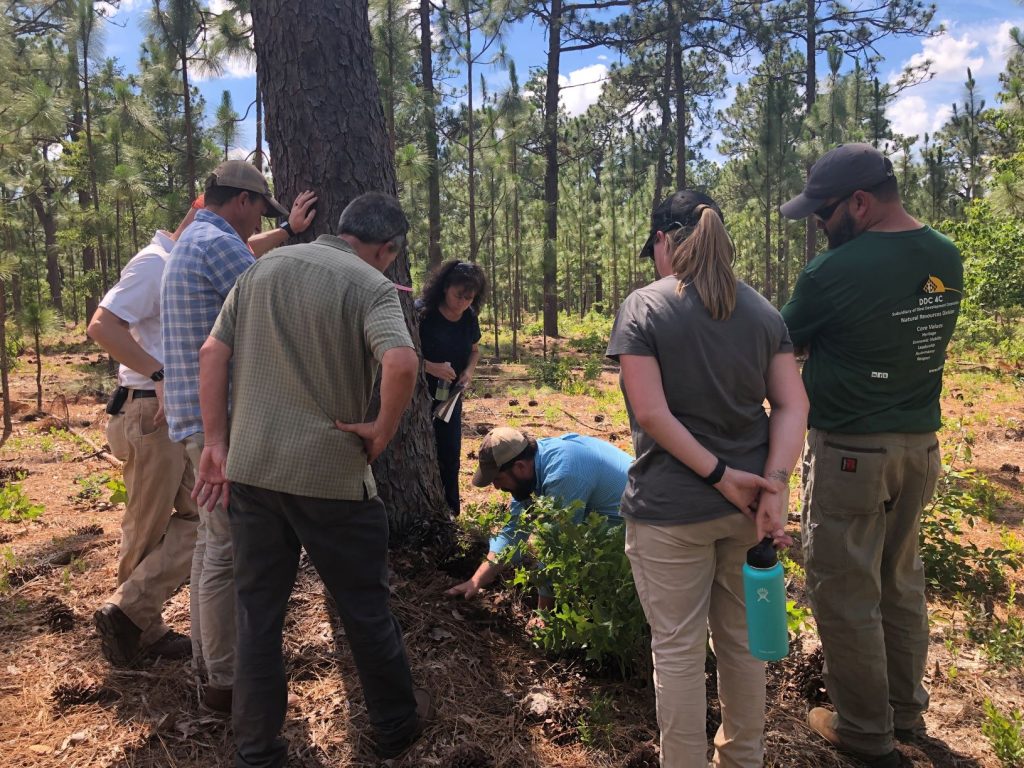Managers and Researchers Connect to Advise on Restoration of Rare Old-Growth Longleaf Tract
By Laurel Kays, NC State Extension Forestry & Southern Fire Exchange, Kevin Hiers, Tall Timbers Research Station, and Dr. Morgan Varner, Tall Timbers Research Station
On a hot June afternoon in North Carolina, professionals from organizations including NC State Extension Forestry, Tall Timbers Research Station, Alachua Conservation Trust and the USDA Forest Service met on a dirt service road on the edge of Fayetteville, to tour the Bonnie Doone old growth longleaf pine tract. The tract is a rare place, but one that has an all too common history for remnant old growth longleaf forests—too little fire. Most know the highlights of the longleaf pine story-how 90 million acres across the South was whittled down to just a few million. How of that few million, only a fraction resembles the old-growth forests that covered the region before turpentining, fire suppression, and the lumber business came along. The 262 acre Bonnie Doone tract is one of largest remaining old-growth stands in North Carolina. Given this rarity, there is substantial and growing interest in helping the City of Fayetteville Public Works Commission, which owns Bonnie Doone, to restore this ecosystem. Perhaps the greatest challenge in that restoration lies in returning frequent prescribed fire to the tract without risking the very trees that make it so special.

To understand why this is so difficult, it is important to understand something called duff. Duff is the layer of the forest floor made up of partly decaying organic matter located between mineral soil and recently fallen, undecayed leaf litter, pine needles, bark and other organic matter. While pine forests in the Southeast that experience regular fire typically have little to no duff, after a few decades of fire exclusion duff forms as the debris that was once burned away accumulates, particularly near large trees.
While a few inches of organic material hiding under recent needle cast doesn’t seem significant to the naked eye, the presence of this duff layer makes it exceptionally difficult to reintroduce fire to stands, including the one at Bonnie Doone. Duff tends to be deepest at tree bases, particularly larger ones, and if fire is reintroduced to a stand without consideration of the duff moisture, the duff layer will ignite. Smoldering combustion in the duff then heats the area around tree stems for long periods, injuring and killing fine roots that have grown into the duff layer. These root injuries stress the pines and often cause mortality, particularly in larger trees, 12-18 months after the fire. Also significant to the Bonnie Doone Tract, smoldering duff can create smoke management hazards to those on the roads that surround this remnant forest. Yet the proximity to well-traveled roads and the city of Fayetteville also put the stand at risk from wildfire, which when ignited would lead to near certain loss of the rare old-growth trees.
Given these constraints, fire managers will attempt to thread a needle and protect against the hazards of an inevitable wildfire while avoiding the smoldering fires that kill old trees and creates smoke management challenges. With just a few successful fires however, the managers of the Bonnie Doone Tract hope to improve habitat for desired species like red-cockaded woodpecker and promote native groundcover plants dependent on frequent fire. While the path toward restoring Bonnie Doone will be complicated, fortunately many other old-growth remnants have successfully been put on the path to restoration.
The visiting professionals that gathered at Bonnie Doone in June included the authors of this piece. Dr. Morgan Varner (USDA Forest Service) and Kevin Hiers (Tall Timbers Research Station) have long worked on challenges surrounding duff management, both through research and on-the-ground management. As we counsel managers on reintroducing fire, we emphasize that restoration success of these fragile, rare forests is dependent upon being patient and strategic when choosing the first burn. Wendy Dunaway, the burn contractor working on the site, and the forester writing a stewardship plan for the property led discussion with the full group on how to practically reintroduce fire to the site while minimizing the risk of losing the old trees that make it so precious.
The reintroduction of fire to Bonnie Doone will be a long process. As we noted many times during the visit, the duff accumulation that took place over decades cannot be undone overnight. But delays in starting the process continue to put the stand at risk from wildfire. Together, the group was able to provide actionable steps to begin the process, and we hope to continue to provide assistance to the Public Works Commission as it moves forward with management on of this critical old growth forest.